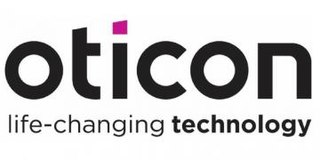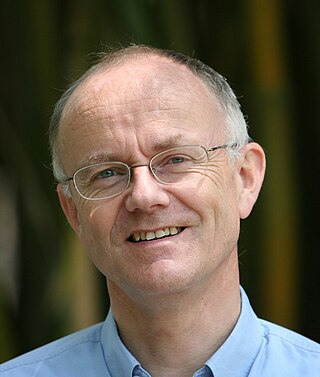
A cochlear implant (CI) is a surgically implanted neuroprosthesis that provides a person who has moderate-to-profound sensorineural hearing loss with sound perception. With the help of therapy, cochlear implants may allow for improved speech understanding in both quiet and noisy environments. A CI bypasses acoustic hearing by direct electrical stimulation of the auditory nerve. Through everyday listening and auditory training, cochlear implants allow both children and adults to learn to interpret those signals as speech and sound.
Sennheiser electronic GmbH & Co. KG is a German audio equipment manufacturer headquartered in Wedemark. Sennheiser specializes in equipment for both the consumer and professional audio markets, including microphones, headphones, and loudspeakers.
Bone conduction is the conduction of sound to the inner ear primarily through the bones of the skull, allowing the hearer to perceive audio content even if the ear canal is blocked. Bone conduction transmission occurs constantly as sound waves vibrate bone, specifically the bones in the skull, although it is hard for the average individual to distinguish sound being conveyed through the bone as opposed to the sound being conveyed through the air via the ear canal. Intentional transmission of sound through bone can be used with individuals with normal hearing — as with bone-conduction headphones — or as a treatment option for certain types of hearing impairment. Bones are generally more effective at transmitting lower-frequency sounds compared to higher-frequency sounds.
Auditory neuropathy (AN) is a hearing disorder in which the outer hair cells of the cochlea are present and functional, but sound information is not transmitted sufficiently by the auditory nerve to the brain. The cause may be several dysfunctions of the inner hair cells of the cochlea or spiral ganglion neuron levels. Hearing loss with AN can range from normal hearing sensitivity to profound hearing loss.
Unilateral hearing loss (UHL) is a type of hearing impairment where there is normal hearing in one ear and impaired hearing in the other ear.

Sonova Holding AG is an internationally active Swiss group of companies headquartered in Stäfa that specializes in hearing care. The Sonova group operates through its core business brands Phonak, Unitron, Hansaton, Advanced Bionics, AudioNova and Sennheiser. It is one of the largest providers in the sector worldwide. The group and its brands hold 24% of the global hearing aid market in sales. As of 11 September 2022, Sonova was a component of the Swiss Market Index.
Graeme Milbourne Clark is an Australian Professor of Otolaryngology at the University of Melbourne. Worked in ENT surgery, electronics and speech science contributed towards the development of the multiple-channel cochlear implant. His invention was later marketed by Cochlear Limited.

A bone-anchored hearing aid (BAHA) is a type of hearing aid based on bone conduction. It is primarily suited for people who have conductive hearing losses, unilateral hearing loss, single-sided deafness and people with mixed hearing losses who cannot otherwise wear 'in the ear' or 'behind the ear' hearing aids. They are more expensive than conventional hearing aids, and their placement involves invasive surgery which carries a risk of complications, although when complications do occur, they are usually minor.

The House Institute Foundation (HIF), formerly the House Ear Institute, is a non-profit 501(c)(3) organization, based in Los Angeles, California, and dedicated to advancing hearing science through research, education, and global hearing health to improve quality of life.

Cochlear is a medical device company that designs, manufactures, and supplies the Nucleus cochlear implant, the Hybrid electro-acoustic implant and the Baha bone conduction implant.

Oticon is a hearing aid manufacturer based in Copenhagen, Denmark. The company is a subsidiary of Demant A/S. It was founded in 1904 by Hans Demant, whose wife was hearing impaired. The company claims to be the world's second-largest manufacturer of hearing aids, and uses a management style known as "spaghetti organization" introduced by Lars Kolind under his leadership between 1988 and 1998.
Coloplast A/S is a Danish multinational company that develops, manufactures and markets medical devices and services related to ostomy, urology, continence, and wound care.

GN Store Nord A/S is a Danish manufacturer of hearing aids, speakerphones, videobars and headsets. GN Store Nord A/S is listed on NASDAQ OMX Copenhagen.

Lars Kolind is a Danish businessman. Kolind holds an M.Sc. in Mathematics from Aarhus University from 1972 and a B.Comm. from the Copenhagen Business School from 1977. He is adjunct professor of leadership and strategy at Aarhus University Business School since 2000. He serves as Detao Master of Leadership and Strategy since 2012.
Bernafon is a globally operating company that defines and markets hearing aids and hearing aid accessories, including fitting software and consumer apps. Headquartered in Bern, Switzerland, the company employs some 500 people worldwide and operates in over 70 countries.

Ingeborg J. Hochmair-Desoyer is an Austrian electrical engineer and the CEO and CTO of hearing implant company MED-EL. Dr Hochmair and her husband Prof. Erwin Hochmair co-created the first micro-electronic multi-channel cochlear implant in the world. She received the Lasker-DeBakey Clinical Medical Research Award for her contributions towards the development of the modern cochlear implant. She also received the 2015 Russ Prize for bioengineering.
Cochlear Bone Anchored Solutions is a company based in Gothenburg, Sweden that manufactures and distributes bone conduction hearing solutions under the trademark Baha. The company was founded in 1999 under the name Entific Medical Systems. When Cochlear bought the company in 2005, the name was changed to Cochlear Bone Anchored Solutions. The acronym "BAHA" was trademarked into Baha, as it is not considered a hearing aid by insurance companies.

MED-EL is a global medical technology company specializing in hearing implants and devices. They develop and manufacture products including cochlear implants, middle ear implants and bone conduction systems.

The Bionics Institute is an Australian medical research institute focusing on medical device development. It is located in Melbourne, Australia.
Niels B. Christiansen is a Danish businessman who is the current president and chief executive officer of The Lego Group.









